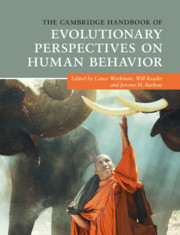Book contents
- The Cambridge Handbook of Evolutionary Perspectives on Human Behavior
- The Cambridge Handbook of Evolutionary Perspectives on Human Behavior
- Copyright page
- Dedication
- Contents
- Figures
- Tables
- Contributors
- Preface
- Acknowledgments
- Part I The Comparative Approach
- Part II Sociocultural Anthropology and Evolution
- Part III Evolution and Neuroscience
- Part IV Group Living
- Part V Evolution and Cognition
- Part VI Evolution and Development
- Part VII Sexual Selection and Human Sex Differences
- Part VIII Abnormal Behavior and Evolutionary Psychopathology
- Part IX Applying Evolutionary Principles
- Part X Evolution and the Media
- 42 Daily Talk Shows as Virtual Gossip Communities
- 43 Supernormal Stimuli in the Media
- 44 An Evolutionary Approach to Horror Media
- 45 The Internet Is for Porn
- Index
- References
44 - An Evolutionary Approach to Horror Media
from Part X - Evolution and the Media
Published online by Cambridge University Press: 02 March 2020
- The Cambridge Handbook of Evolutionary Perspectives on Human Behavior
- The Cambridge Handbook of Evolutionary Perspectives on Human Behavior
- Copyright page
- Dedication
- Contents
- Figures
- Tables
- Contributors
- Preface
- Acknowledgments
- Part I The Comparative Approach
- Part II Sociocultural Anthropology and Evolution
- Part III Evolution and Neuroscience
- Part IV Group Living
- Part V Evolution and Cognition
- Part VI Evolution and Development
- Part VII Sexual Selection and Human Sex Differences
- Part VIII Abnormal Behavior and Evolutionary Psychopathology
- Part IX Applying Evolutionary Principles
- Part X Evolution and the Media
- 42 Daily Talk Shows as Virtual Gossip Communities
- 43 Supernormal Stimuli in the Media
- 44 An Evolutionary Approach to Horror Media
- 45 The Internet Is for Porn
- Index
- References
Summary
People generally try to avoid negative emotions such as fear, anxiety, and terror – and unsurprisingly so. These negative emotions evolved to motivate defensive avoidance behavior and are elicited by threatening stimuli. Common sense tells us that nobody desires to dwell on such stimuli, and yet a good chunk of the entertainment industry is devoted to manufacturing products designed to instill negative emotions in consumers. Horror cinema, horror literature, and horror video games are all thriving industries. Every season sees a new crop of novels, films, and video games depicting rotting monsters, moaning ghosts, and terrifying situations. Why do such media products draw large audiences? This chapter proposes to answer that question by invoking an evolutionary explanatory paradigm that builds on the evolutionary social sciences and encompasses sociological and historicist approaches to horror (Clasen, 2012, 2017).
- Type
- Chapter
- Information
- Publisher: Cambridge University PressPrint publication year: 2020



